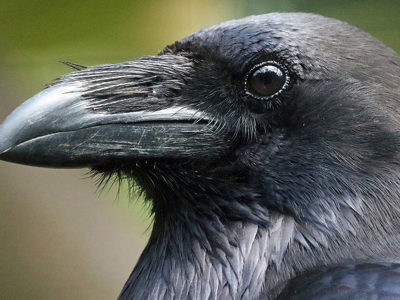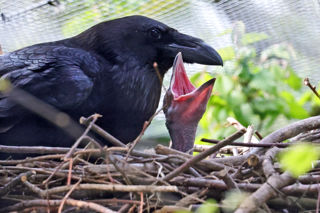
Raven
Corvus corax
The Raven is the largest member of the crow family (corvids), completely black in colour, with a wingspan of 120-150cm and an average weight of 0.8g-1.5kg. The feathers around their neck appear shaggy, and their tails are diamond shaped when flying.
Their bills are considerable large or chunky looking when compared to crows. Ravens have a huge repertoire of vocalisations, mainly for social interactions.
Behaviour
Highly intelligent, non-migratory bird that forms monogamous pairs and territories. Juvenile ravens form large groups before they have paired up. Nests are normally built high up in trees or cliffs, and made of sticks and lined with fur, grass or mud. Excellent problem solvers.
UK Status
Once widespread in the UK, their range was pushed to the west and north of the UK, to remote mountainous regions. In the early 1990s, after more than a century, Ravens were shown to be recovering.
Currently found in south-west England, the Lake District, Wales and much of Scotland, their range is expanding still and moving towards the south-east. Has full protection under the Wildlife and Countryside Act (1981), meaning it is illegal to kill a raven and there are strict licenses in order to control them.
Threats
Throughout Europe ravens were persecuted due to fear, superstition and as a pest animal from the 17th century onwards. Present day threats to this species is likely the intensive farming practices across Europe which leads to habitat destruction and disturbance.

Distribution
One of the largest distributions of any passerine bird. Can be found from Arctic habitats in the North, to the deserts of Africa in the south. Wide ranging across Europe, Asia, and North America.
Habitat
Highly adaptable species that can inhabit virtually any habitat in the Northern hemisphere. Known to avoid large urban areas, but otherwise is found breeding in both forested and open areas, be that coastal, mountain, tundra and cliff regions.
Diet
Highly opportunistic and omnivorous, with diets varying greatly with location, season and opportunities. Mainly scavengers, they also prey on small invertebrates, reptiles, amphibians, small mammals, birds and eggs. Berries, fruits and cereal grains are also eaten.
Wildwood inside info
Wildwood is home to a pair of male and female Ravens (named Ike and Beena respectively), located just between our conservation office and bird of prey flight ground. These birds do not shy away from people and are regularly making lots of noises both to each other and passers-by. Don’t be squeamish either, as they’re sure to put on a show for you when they’re eating their dinner (which normally involves a rabbit or rat being tossed around their enclosure!)
Family facts
15-30 categories of vocalisations have now been recorded. Known to also be very talented mimics, and can imitate human speech.
A group of ravens is called a “conspiracy” or an “unkindness”.
Ravens are common in myths and legends throughout the world, often regarded as a messenger from the gods. Are also seen as bad omens in some cultures too.
Ravens have traditionally been kept at the Tower of London. Legend has it that their presence is to protect the crown and “if the Tower of London ravens are lost or fly away, the Crown will fall and Britain with it.”
Are Kleptoparasites of wolves; following wolves on a hunt in order to scavenge on the remains of their kills.

